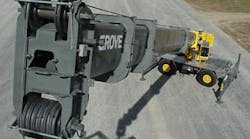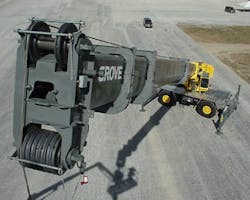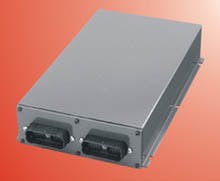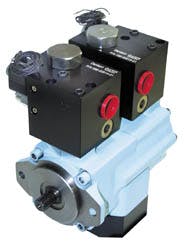Sophisticated controls for powerful machines
By Alan L. Hitchcox, editor
Tasks performed by cranes and garbage trucks aren’t hi-tech, but their hydraulic controls can be.
Among other goals for an upgrade in the RT series, Grove engineers wanted to incorporate smart engine technology, decrease the number of slip rings between the superstructure (turret) and the carrier (chassis), and eliminate relays wherever possible. According to Sid Shreiner, lead engineer for Grove on the project to make these changes, "We didn't want to take the development on ourselves, so we looked for someone who could offer us proven technology." Among the expertise of HED is the development of CAN components, software, and systems.
Electronic makeover
Grove's RT-900 was the first of its models to be upgraded, to the RT-9130E. This 130-ton crane is powered by a Cummins QS-series 300-hp diesel engine. This engine's drive-by-wire technology helps reduce emissions and improve operator control. It is accomplished through an energy-saving engine controller unit, which monitors information from various points of the engine, such as oil temperature, oil pressure, and speed. Routing this information to a central control helps improve the operation and efficiency of the entire machine.
The portion of the project that required developing a CAN system took roughly four months, including prototype testing. HED determined that two microprocessor modules from their CANLink multiplexed family of controls would suffice - a carrier-mounted CL-404 and a CL-403 mounted to the superstructure.
Two modules share duties
The CL-403 has 41 inputs and primarily processes commands from the operator's cab. The module's 21 outputs include 15 low-power outlets that send information to standard dashboard analog gauges and operate cab comfort features. Four 2.5-A outlets control crane action and up-and-down motion of the 5-section, hydraulically powered boom. This boom can extend out to 160 ft and boasts a 5-ton hoist capacity at its end. The control also prevents overextension of the boom based on load calculations.
The module has a built-in gauge driver and has five low-power sinking PWM outputs for driving analog-type gauges and nine sinking on-off outputs for the indicator lights.
The two modules are inter-related in that information is shared, and commands are handled by one module. A twisted pair of wires sends communications between the components using the SAE J1939 protocol. By operating toggle switches and a joystick in the cabin, the driver sends commands to the CL-403. Signals meant for the outriggers and the engine travel on to the CL-404.
Reducing slips
Because the superstructure rotates relative to the carrier, slip rings are necessary in the wiring circuit between the two control modules. But serial communication between the modules significantly reduces the number of wires needed for operating or monitoring each component on the crane. As a result, the RT-9130E has just 13 slip rings - as opposed to the 55 found on its predecessor, the model RT-900. This makes operation of the newer version more reliable, and easier to manufacture and service. In addition, the RT-9130E requires fewer relays.
The modules offer this sophisticated control in a package that defies field conditions. Their cases meet NEMA-4 rating for dust- and water-tight sealing, and their electronic boards withstand motion shock during operation and are unaffected by typical electromagnet and radio frequency interference.
To increase reliability of service, HED provides its Diagnostic Tool software, which Grove makes available to its service reps and dealers. A laptop connects to a RS232/serial port on the modules.
Refuse truck business is “picking up”
The operator need not shift the truck into neutral nor rev the engine to the 1,200 to 1,500 rpm otherwise required by conventional systems. The end result is that operators can run their collection vehicles more efficiently, more productively, with less maintenance, and with less noise than conventional systems.
The OASIS system incorporates a standard Denison double-vane pump, three manifold blocks with internal check capabilities (one on each outlet port and one on the single inlet port, plus solenoid unloading cartridge valves), and an electronic controller. By providing a vane pump with high efficiency and large displacement, the OASIS system can supply the hydraulic flow required to operate lift-and-load functions at engine idle speeds.
An electronic control module monitors engine speed and safely sequences two solenoid unloader valves on the double-vane pump's outlet ports. This causes both sections of the pump to be used at idle speed. At higher speed, one section is deactivated, and at very high (driving) speeds, both sections are deactivated. The net result: a relatively constant flow to allow full operation of lift-and-load functions even when the engine speed is at a normal idle.
By controlling solenoid actuated unloader valves, pump outlet flow can be directed back to the reservoir or to the pump's suction port at low pressure. This eliminates high fluid temperatures associated with high pressure drops across a typical mobile hydraulic valve bank.
The benefits of this system are most apparent with refuse trucks operating at severe duty cycles. Typically, these are automated side loaders serving a municipality. Some of these machines operate at up to 1,100 duty cycles a day. With an OASIS system installed, the operator only needs to pull alongside a refuse container, step on the brake to hold position, then operate the lift-and-load arm - with no need to even put the vehicle in neutral.
The vehicle's normal idle speed is within transmission manufacturers' specifications for stop-and-go operation and will not harm the torque converter or cause damage from heat buildup. The operator also saves time and mechanical stress because no gearbox shift operations are needed.
Major benefits of the OASIS system include:
* Reduced fuel consumption of 15% to 30%
* Longer pump life - up to three times longer than a gear pumps
* High reliability
* Quiet operation - important for refuse trucks that must operate in residential neighborhoods
* Lower system operating temperatures, which further improves reliability
* Higher productivity - 15% can be cut from the time to complete a route
* Less operator fatigue





